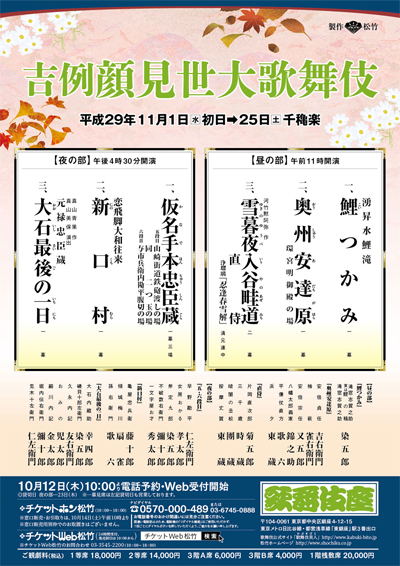| NOVEMBER 2017 |
| Kabukiza (T˘ky˘) |  |
| Dates | 1 ~ 25 November 2017 (Kichirei Kaomise ďkabuki) Annual Festive Face-Showing Grand Kabuki |
| MatinÚe |
Waki Noboru Mizu-ni Koi Taki (Koi Tsukami) |
| Evening |
|
| Casting |
Living National Treasure Sakata T˘jűr˘, Living National Treasure Onoe Kikugor˘, Living National Treasure Kataoka Nizaemon, Living National Treasure Nakamura T˘z˘, Matsumoto K˘shir˘, Nakamura Jakuemon, Nakamura Tokiz˘, Nakamura Senjaku, Kataoka Hidetar˘, Ichikawa Somegor˘, Kataoka Takatar˘, Nakamura Kinnosuke, Ichikawa Danz˘, Band˘ Yajűr˘, Nakamura Karoku, Nakamura Matagor˘, ďtani Tomoemon, Ichikawa Sai'nyű, Ichimura Kakitsu, Band˘ Shűch˘, Ichikawa Komaz˘, Band˘ Hikosabur˘, Kamimura Kichiya, Sawamura Yoshijir˘, Matsumoto Kingo, ďtani Keiz˘, Nakamura Kotar˘, Matsumoto Kintar˘, ďtani Hirotar˘, Kataoka Matsunosuke, Nakamura Kichinoj˘ |
| Comments |
The traditional November kaomise programs at the Kabukiza!
|
 |
| National Theatre (T˘ky˘) |
| Dates | 3 ~ 26 November 2017 |
| Program | |
| Casting |
Nakamura Baigyoku, Nakamura Kaishun, Onoe Sh˘roku, Ichikawa Sadanji, Band˘ Rakuzen, Kawarasaki Gonjűr˘, Ichimura Manjir˘, Band˘ Kamez˘, Nakamura Baishi, Nakamura Matsue, Nakamura Kash˘, Arashi Kitsusabur˘, Ichimura Takematsu, Onoe Sakon, Ichikawa Otora, Nakamura Tamatar˘, Ichimura Kitsutar˘, Nakamura Kamenoj˘ |
| Comments |
Two Shinkabuki dramas are staged this month at the National Theatre, with Nakamura Baigyoku, Nakamura Kaishun and Onoe Sh˘roku as leading actors. These two dramas have not been staged for 36 years. Yamamoto Yűz˘'s drama "Sakazaki Dewa-no-Kami" was staged for the last time in February 1981 at the Kabukiza and it is staged to commemorate the 130th birthday of Yamamoto Yűz˘. Hasegawa Shin's drama "Kutsukake Tokijir˘" was staged for the last time in December 1981 at the Kabukiza.
|
 |
| Eirakukan (Toyooka) |  |
| Dates | 4 ~ 12 November 2017 (Eirakukan ďkabuki) Eirakukan Grand Kabuki |
| Program |
Sengokubune Hogake no Shirahama Iya Sakae Izushi no Nigiwai |
| Casting |
Kataoka Ainosuke, Nakamura Ganjir˘, Nakamura Kazutar˘, Nakamura Jűjir˘, Nakamura Tanenosuke |
| Comments |
This is the 10th Kabuki program at the Eirakukan, a renovated traditional theater built in the city of Toyooka (prefecture of Hy˘go). The first item in the program is the revival of the oiemono drama "Sengokubune Hogake no Shirahama", a drama which was premiered in July 1888 at the Shintomiza and which was related to the Sengoku Disturbance (Sengoku S˘d˘) in the Izushi-han whose castle town was Izushi, the city where the Eirakukan was built. The second item is a newly-created Kabuki drama based on the dance-drama "Genroku Hanami Odori", which celebrates the 10th anniversary of the Kabuki performances at the Eirakukan. |
|
|||
| Dates | 31 October ~ 5 November 2017 (Band˘ Tamasabur˘ Tokubetsu Buy˘ K˘en) Band˘ Tamasabur˘ Special Dance Performances |
||
| MatinÚe | |||
| Evening |
Inabune |
||
| Casting |
Living National Treasure Band˘ Tamasabur˘ |
||
| Comments |
A special Buy˘ program starring the amazing Living National Treasure onnagata Band˘ Tamasabur˘ in Yamaga at the Yachiyoza, a traditional wooden-built theater. For the first time, with these programs, there will be a mix of video projection (with video sequences coming from the high-quality Shinema Kabuki, "Cinema Kabuki") and real dancing on stage. In "Sagi Musume", only the opening sequence is video-projected. Most of the dance will be performed on staged by Band˘ Tamasabur˘. "Musume D˘j˘ji", the travel scene (michiyuki) is skipped and the kaneiri scene ("entering the bell") is video-projected. Others main scenes, like the koi no tenarai scene ("learning about love"), are staged.
|
||
| Kinshű Special Tour | |
| Dates | 3 ~ 26 November 2017 |
| Program |
Kabuki-juku |
| Casting |
Nakamura Kankur˘, Nakamura Shichinosuke, Nakamura Tsurumatsu |
| Comments |
The word kinshű means "Autumn Brocade". This Autumn tour stars Nakamura Kankur˘ and Nakamura Shichinosuke. The first item in the program is a speech/presentation on stage about some aspects of Kabuki.
|
| Sh˘chiku Grand Kabuki Tour | |
| Dates | 1 ~ 26 October 2017 (Sh˘chiku ďkabuki) Sh˘chiku Grand Kabuki |
| Program | |
| Casting |
Nakamura Shid˘, Kataoka Kamez˘, Nakamura Kikaku, Sawamura S˘nosuke, Nakamura Mantar˘, Nakamura Yonekichi, Nakamura Baika |
| Comments |
The Sh˘chiku Grand Kabuki Fall Tour in 20 cities.
|
| Shinbashi Enbuj˘ (T˘ky˘) |  |
| Dates | 6 October ~ 25 November 2017 (SűpÔ Kabuki Sekando) Super Kabuki II |
| Program |
ONE PIECE |
| Casting |
Band˘ Takesabur˘, Ichikawa Udanji, Ichikawa Monnosuke, Ichikawa Omez˘, Ichikawa Emisabur˘, Ichikawa Emiya, Ichikawa En'ya, Ichikawa Juen, Ichikawa K˘tar˘, Band˘ Minosuke, Band˘ Shingo, Nakamura Hayato, Onoe Ukon |
| Comments |
The SűpÔ Kabuki Sekando drama "ONE PIECE", based on Oda Eiichir˘'s internationally popular manga "ONE PIECE", which got his first very successful stage adaptation by Ichikawa Ennosuke in October 2015/November 2015 at the Shinbashi Enbuj˘, is staged one more time in T˘ky˘. Most of the actors are Kabuki actors, with 3 non-Kabuki guest actors : Hira Takehiro, Kashima Noritoshi and Asano Kazuyuki. It is almost the same cast as in 2015 (minor differences).
|
| Classics Tour | |
| Dates | 12 October ~ 25 November 2017 (Koten he no Izanai ~ Shűki K˘en) Invitation to the Classics ~ Fall Performances |
| Program |
Otokodate Hana no Yoshiwara |
| Casting |
Ichikawa Ebiz˘, Kataoka Ichiz˘, Ichikawa Kudanji, ďtani Hiromatsu |
| Comments |
The Fall Tour of Ichikawa Ebiz˘ with performances in 17 cities.
|
|
|
| Contact | Main | Top | Updates | Actors | Plays | Playwrights | Programs | Links | FAQ | Glossary | Chronology | Illustrations | Prints | Characters | Derivatives | Theaters | Coming soon | News |